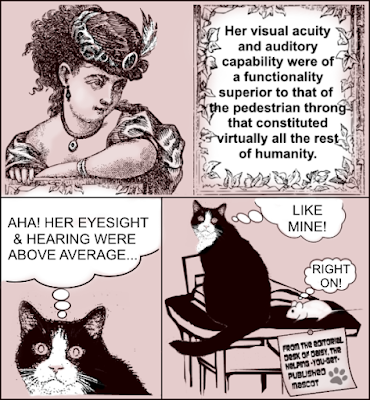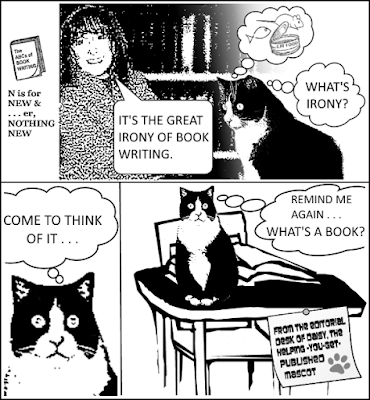 |
View larger image: Right click;
then left click "Open link in new
window." Zoom to 200% or
preferred size.
|
Most writers know what to do with the period, question mark, and exclamation point—the punctuation that typically signals sentence endings. The most prevalent internal sentence punctuation, the comma, is not as well understood. In my work as an editor, I notice widespread misuse or absence of commas, as well as uncertainty about how and when to deploy less familiar punctuation marks such as the semicolon and em dash.
Increasing their punctuation know-how is an effective, but often overlooked, way for writers to enhance the ease and impact of their writing. What follows is not an exhaustive course in punctuation, but a few quick pointers about the uses and versatility of common punctuation marks in English-language writing.
End-of-sentence punctuation: period, exclamation point, question mark
Insert—
—a period to conclude a statement:
Nothing could be more simple.
—a question mark to end with an inquiry or, occasionally, a note of irony or disbelief:
What time did you arrive? What did you do next?
You did what?
—an exclamation point to end with an emphatic flourish:
I could not believe my eyes!
Note: Be sparing with exclamation points. Using too many of them depletes their emphatic power: It's true! I mean it! Really!
Other end-of-sentence punctuation
Use—
—an em dash for speech or thought interrupted:
"But you said you would—"
"I changed my mind," she snapped, disliking his accusatory tone.
—ellipsis points to indicate ongoing action or voice trailing off in dialogue:
The ships sailed in and out of the harbor. . . .
"But I was so sure it would all work out. . . ." He had to lean in close to hear the last part of what she said.
Internal sentence punctuation: the comma
Insert a comma—
—to signal a pause:
When he was a boy, his family home did not have electricity.
Possibly, the whole plan was a mistake.
At certain times, there is no need to apologize.
Note: In examples like the three above, the comma is often optional, according to the writer's ear and need for emphasis. If in doubt, retain the comma to ensure clarity. In many instances, using an optional comma will add a subtle note of emphasis to the statement. Compare the second and third examples above to these:
Possibly the whole plan was a mistake.
At certain times there is no need to apologize.
Also use a comma—
—to offset added descriptive or explanatory content:
The salesman, whose smile looked pasted onto his face, approached with a determined step.
—to list items in a series:
She was warmly dressed in a coat, hat, scarf, and pair of fleece-lined boots.
Note: The final comma in the series is optional, but most stylists recommend its inclusion.
—to separate the main parts of compound and/or complex sentences:
Simple sentence, no comma: Mary walked away.
Compound: Mary turned her back on him, and then she walked away.
Complex: Because she had nothing more to say to him, Mary walked away.
Complex/compound: Because she had nothing more to say, Mary turned her back on him, and then she walked away.
Other internal sentence punctuation
Use—
—a semicolon when ideas are closely connected, and making two sentences would create choppiness:
One cat was white; the other was orange. (Instead of: One cat was white. The other was orange.)
Note: As a rule, in this kind of construction, avoid inserting a comma and creating a run-on sentence (a.k.a. comma fault or comma splice)—as in: One cat was white, the other was orange. For further discussion of the run-on sentence and its fixes, see "E is for EMAIL".
In other kinds of sentences, insert—
In other kinds of sentences, insert—
—a colon to introduce a list, or to augment or complete preceding information:
 |
| Example of ellipsis points used for deliberate effect. |
Jane looked at her watch and saw that she had two choices: she could grab a bite now or go hungry until dinnertime.
—ellipsis points to indicate omissions from quoted material, or to suggest ongoing action and/or time passing:
"When a species . . . increases inordinately . . . , epidemics . . . often ensue."
The clock ticked . . . ticked . . .
ticked . . . and finally struck midnight.
—ellipsis points to indicate omissions from quoted material, or to suggest ongoing action and/or time passing:
"When a species . . . increases inordinately . . . , epidemics . . . often ensue."
The clock ticked . . . ticked . . .
ticked . . . and finally struck midnight.
—two em dashes to offset parenthetical information, or to emphasize added content:
French impressionists—for example, Monet and Degas—brought a new vision to painting.
My best option—or so I thought at the time—was to keep my mouth shut.
Note: The first sentence in the above pair might also use parentheses: French impressionists (for example, Monet and Degas) brought a new vision to painting. Many contemporary stylists favor em dashes over parentheses because the former are more elegant or emphatic in many sentence constructions.
My best option—or so I thought at the time—was to keep my mouth shut.
Note: The first sentence in the above pair might also use parentheses: French impressionists (for example, Monet and Degas) brought a new vision to painting. Many contemporary stylists favor em dashes over parentheses because the former are more elegant or emphatic in many sentence constructions.
In the second sentence, replacing the em dashes with commas would be acceptable, but the use of em dashes creates greater emphasis and/or drama.
And speaking of enhanced effect, instead of a comma try using—
And speaking of enhanced effect, instead of a comma try using—
—a single em dash to add drama to a sentence:
He suddenly got an idea—a brilliant idea that would solve all his problems.
Note: An em dash can be typed as two hyphens (--), but do not use single hyphens in place of em dashes or any other sentence punctuation. Hyphens are for use in compound words and to attach some prefixes and suffixes: kilowatt-hour, mass-produced, co-op, anti-inflammatory, university-wide—to cite just a few well-chosen, high-quality examples of hyphenated words.
He suddenly got an idea—a brilliant idea that would solve all his problems.
Note: An em dash can be typed as two hyphens (--), but do not use single hyphens in place of em dashes or any other sentence punctuation. Hyphens are for use in compound words and to attach some prefixes and suffixes: kilowatt-hour, mass-produced, co-op, anti-inflammatory, university-wide—to cite just a few well-chosen, high-quality examples of hyphenated words.
Learning more about punctuation
The pointers and examples given above are introductory and do not include all forms of punctuation or every usage for the punctuation discussed. For more information about punctuation marks and specialized usages, consult chapter 6 of The Chicago Manual of Style, available in the reference sections of most public libraries. For online information, start at
http://www.chicagomanualofstyle.org/.
http://www.chicagomanualofstyle.org/.
It can take years of writing, editing, and consulting style manuals to become a punctuation expert. But mastering the basics and following punctuation best practice, even at an elementary level, will help ensure clarity and empower your writing.



